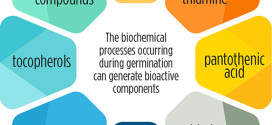El-Sayed M. Abdel-Aal Introduction Pulses are the dry seeds of legumes that contain small amount of fat, while those with high amount of fat are referred to as leguminous oilseeds (soybean and peanut). But the term legume covers all leguminous plants such as dry seeds, green pots/seeds, leguminous oilseeds and other legumes (clover and alfalfa), and food legumes include only …
Read More »Reviews
Fermenting pulses for improved nutrition and functionality
Burcu Cabuk | Darren Korber | Takuji Tanaka | Michael Nickerson* Pulses represent the second most important grain after cereals, with a recorded total production of 77.64 million tonnes in the world, with India, Canada and China representing by far the world’s largest pulse producers1. Pulses are a rich and inexpensive source of proteins, carbohydrates, micronutrients, vitamins, and minerals. These …
Read More »What’s pulse-ible when it comes to extruded products?
Alie Johnston1 | Rebecca Mollard1 | Julianne Curran2 | Peter J Jones1* Health benefits of pulses Pulses are the dry, edible seeds of podded plants in the legume family including chickpeas, dry beans, lentils, and yellow peas. Canadian pulse production represents about 35% of global pulse exports annually. In 2015, Canada exported 6.2 million tons of pulses valued at greater …
Read More »Expanding markets and evolving regulations for Canadian certified organic foods
Lisa F. Clark Today, organic food can be found everywhere from the local farmers’ market to the aisles of Walmart across North America. According to the 2015 International Federation of Organic Movements (IFOAM)’s annual report World of Organic Agriculture: Statistics and Emerging Trends, the global market for organic products was worth $72 billion USD in 2013, an increase of …
Read More »The quest for healthier, more sustainable chocolate
Ryan West | Dérick Rousseau* Chocolate is a centuries-old product turned multibillion dollar industry that is constantly evolving as processing conditions continue to improve and consumers’ needs change. As we presently reside in the age of food science, our understanding of the molecular behaviour of chocolate has not only enhanced both production and quality, but has also brought many questions …
Read More »Extrusion Cooking of Pulses
Aleksandar Yovchev | Michael Nickerson* Photos courtesy Saskatchewan Food Industry Development Centre In today’s marketplace, the nutritional quality of food products is of the upmost importance to the consumer. Pulses are a protein, carbohydrate, vitamin and mineral rich raw material that are underutilized in the food industry. One of the reasons for this is that in general the cooking of …
Read More »Positioning High-Quality Plant-Based Protein Sources For The Food Industry: Do we need to adopt new approaches?
James D. House1,2,3,4 | Matthew Nosworthy1 Consumers continue to demand products that feature protein claims on front of the package, with protein featured as one of the top 10 key trends in food, nutrition and health for 2015.1 Factors driving increased interest in protein include perceptions by consumers of the linkage between protein consumption and increased satiety (feeling of fullness), …
Read More »Is food a sophisticated ordered tool to deliver nutrients?
Sylvie L. Turgeon* | Laurie-Eve Rioux The older reader will probably remember the popular “I am Joe” article series from the Reader’s Digest dedicated to overviewing the human body’s function. One article was specifically dedicated to human stomach function (I am Joe’s stomach). More recently, the “dummies” series has devoted articles to the digestive system with topics highlighting food digestion. …
Read More »The potential of germination (sprouting) for improving the nutritional properties of cereals and pulses
Germination is an effective processing method for improving nutritional quality, reducing anti-nutritive compounds, boosting the level and digestibility of free amino acids and available carbohydrates, increasing mineral bio-availability, and improving the functional properties of cereal and pulses.
Read More »Experiences with Precision Viticulture on Grape Composition and Wine Quality in Ontario
Andrew Reynolds The Ontario wine industry produces ≈ 65,000 tonnes of grapes and consists of varieties such as Riesling, Chardonnay, and Cabernet franc, with lesser quantities of Merlot, Cabernet Sauvignon, and Pinot noir, with a farmgate value of >$62 million (www.grapegrowersofontario.com ). Although most grapes are destined for wine production, a small portion (2164 tonnes in 2014) is processed into …
Read More » Canadian Food Business
Canadian Food Business
